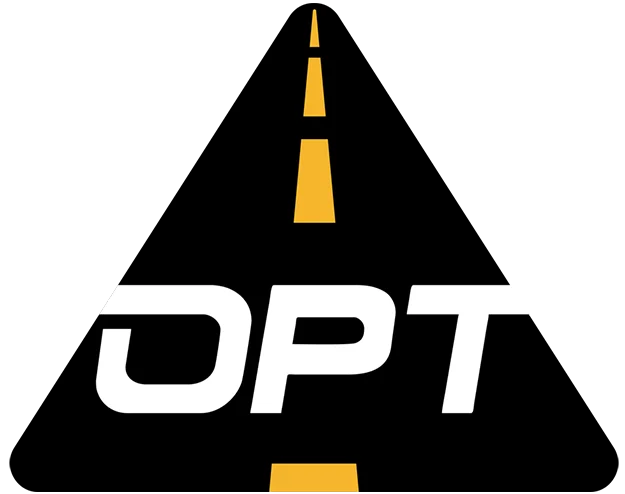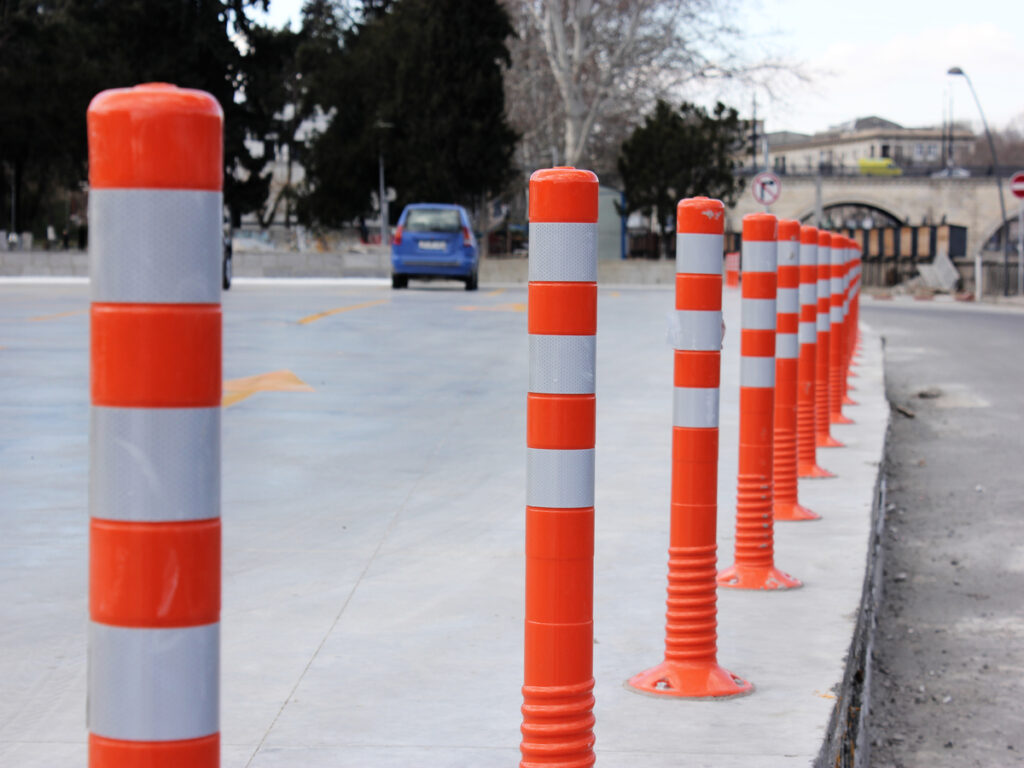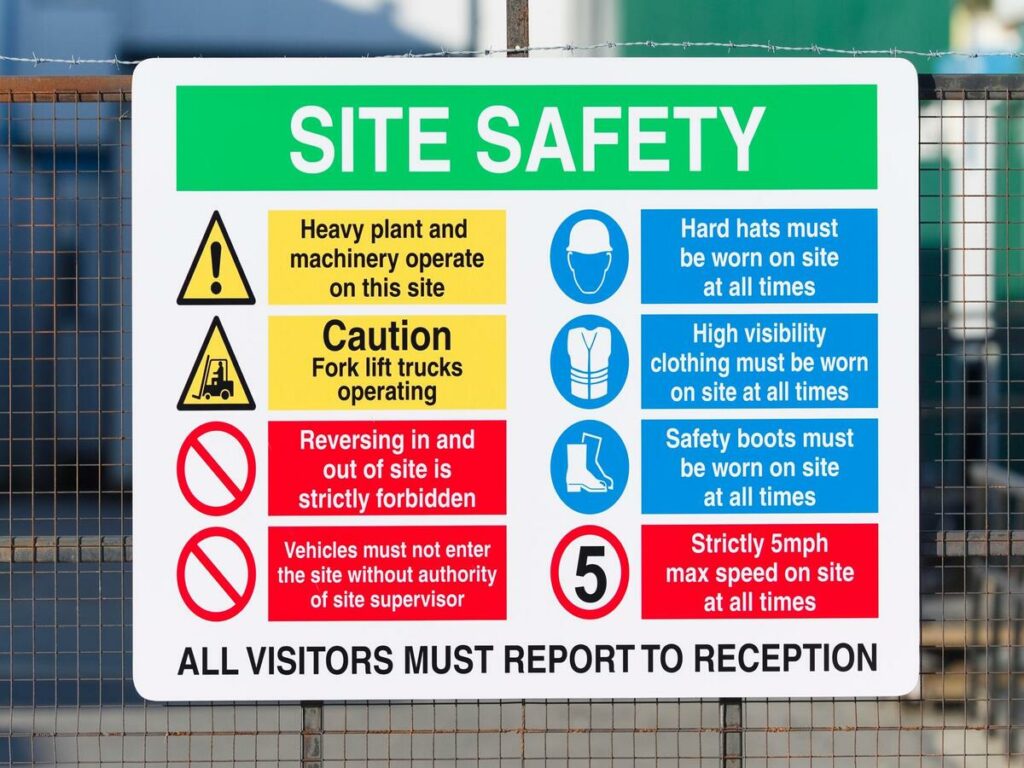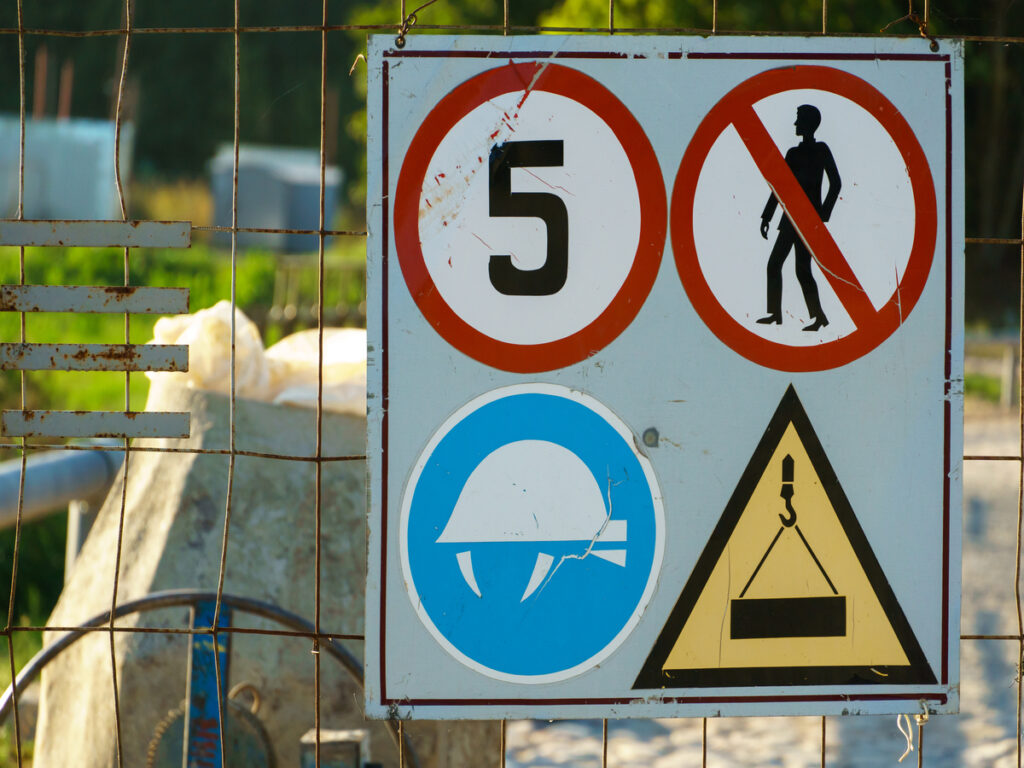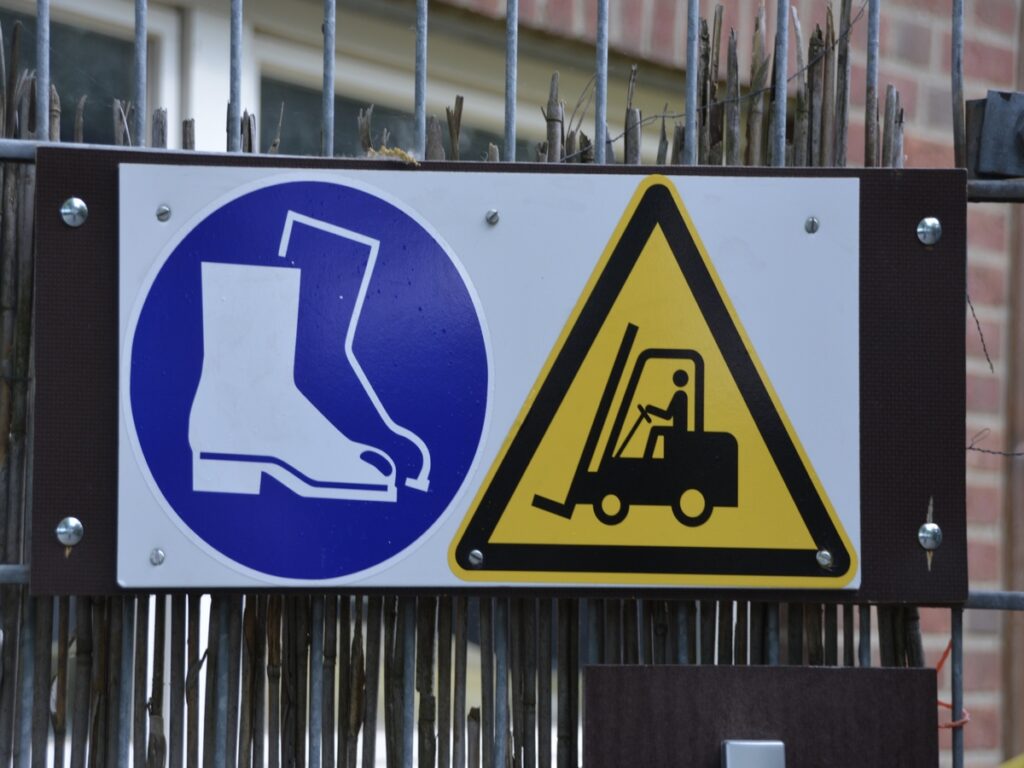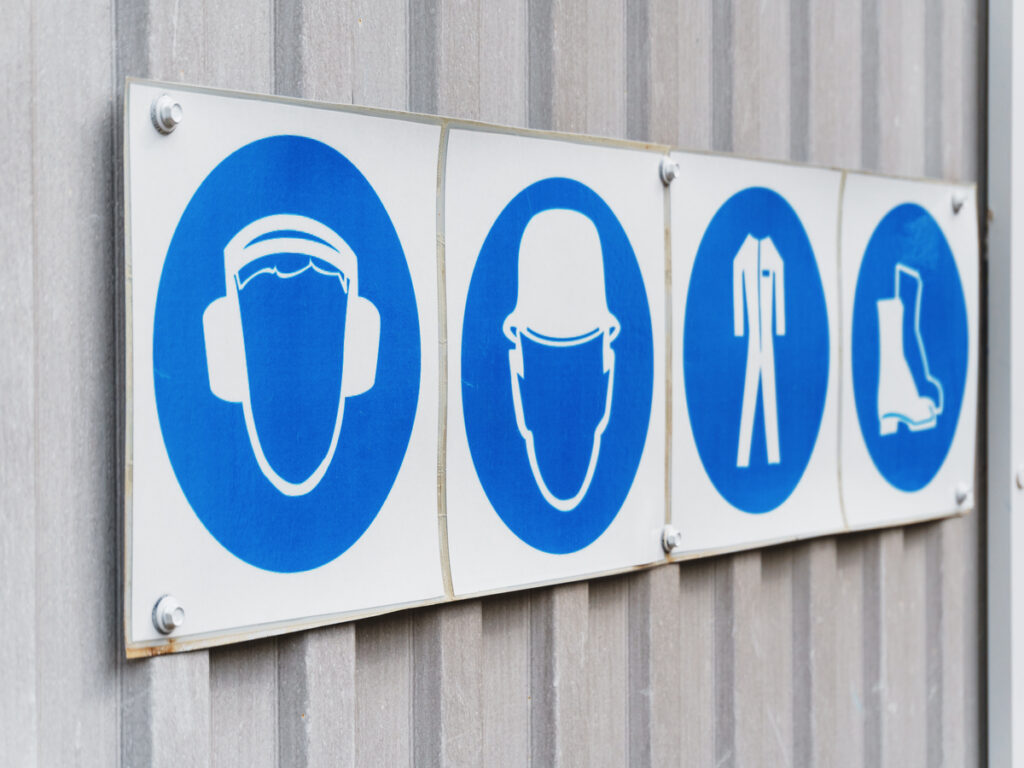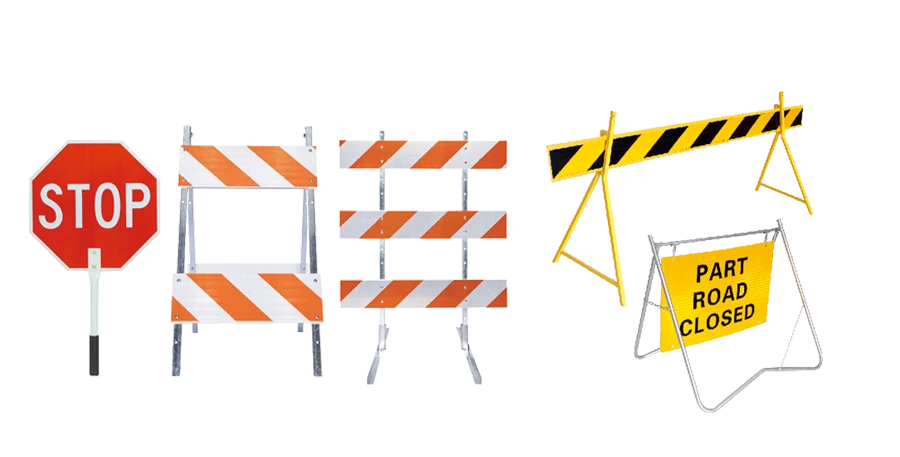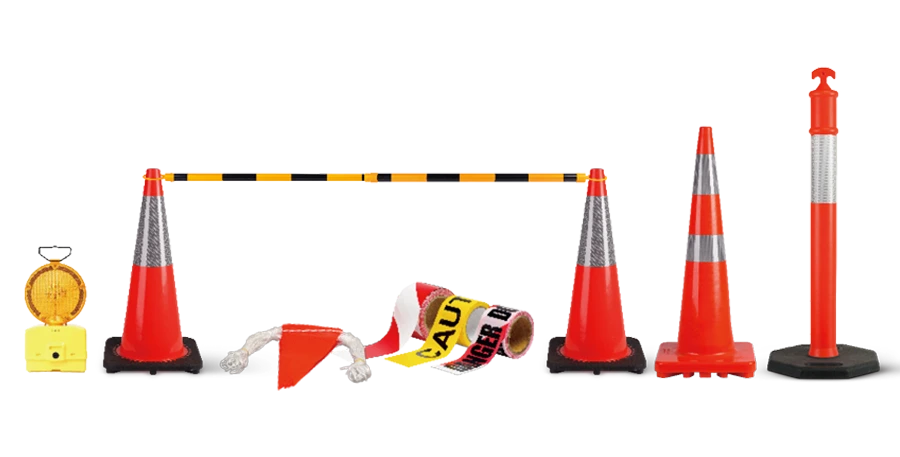
यातायात की भीड़ और सड़क सुरक्षा आधुनिक शहरों में महत्वपूर्ण चुनौतियां बनी हुई हैं. प्रत्येक वर्ष, सड़क यातायात दुर्घटनाओं का दावा 1.35 विश्व स्तर पर मिलियन रहते हैं, दूसरे के साथ 20 को 50 गैर-घातक चोटों से पीड़ित मिलियन लोग. कमजोर सड़क उपयोगकर्ता, पैदल यात्रियों और साइकिल चालकों सहित, इनमें से आधे से अधिक घातक हैं. ये मुद्दे न केवल मानव पीड़ा का कारण बनते हैं, बल्कि एक महत्वपूर्ण आर्थिक बोझ भी लागू करते हैं, तक की लागत 3% उनके वार्षिक सकल घरेलू उत्पाद. स्मार्ट कोन इन समस्याओं का एक अभूतपूर्व समाधान प्रस्तुत करते हैं. उन्नत सेंसर और संचार प्रौद्योगिकी से सुसज्जित, वे सड़क की स्थिति पर वास्तविक समय डेटा प्रदान करके यातायात प्रबंधन को बढ़ाते हैं. यह नवाचार स्मार्ट परिवहन प्रणालियों का समर्थन करता है, सुगम यातायात प्रवाह और सुरक्षित सड़कें सुनिश्चित करना.
तथापि, उन्नत तकनीक के बिना भी, पारंपरिक यातायात शंकु से ओपीटीसंकेत यह अभी भी यातायात प्रबंधन पर महत्वपूर्ण प्रभाव डाल सकता है. उनकी दृश्यमान उपस्थिति यातायात को निर्देशित करने में मदद करती है, खतरनाक क्षेत्र, और श्रमिकों की रक्षा करें, सड़कों पर सुरक्षा और व्यवस्था बढ़ाने के लिए एक सरल लेकिन प्रभावी समाधान पेश करना.
यात्रा समय की विश्वसनीयता का परिचय (टी.टी.आर)
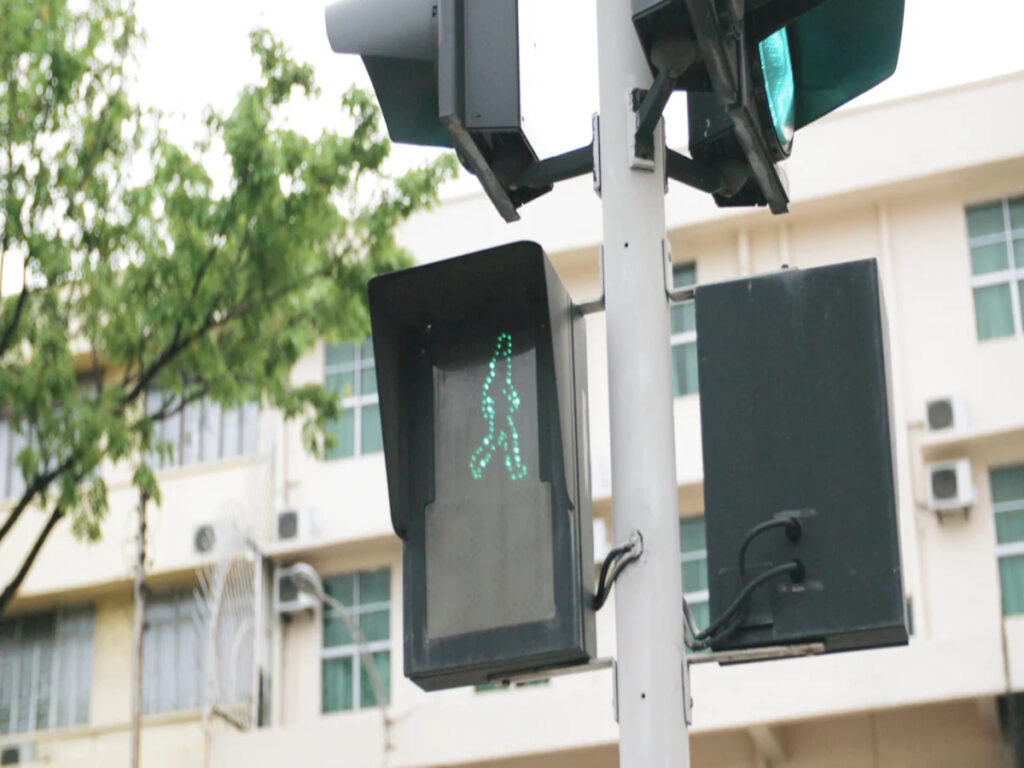
यात्रा समय विश्वसनीयता क्या है? (टी.टी.आर)?
यात्रा के समय की विश्वसनीयता (टी.टी.आर) मापता है कि विभिन्न दिनों और समयों में यात्रा का समय कितना सुसंगत है. यह आपको यह समझने में मदद करता है कि आपको अप्रत्याशित देरी के बिना अपने गंतव्य तक पहुंचने में कितना समय चाहिए. उदाहरण के लिए, यदि आपका दैनिक आवागमन लगता है 30 मिनट एक दिन और 50 अगले मिनट, यात्रा का समय अविश्वसनीय है. विश्वसनीय यात्रा समय आपको आत्मविश्वास के साथ अपनी यात्राओं की योजना बनाने की अनुमति देता है, चाहे काम के लिए, विद्यालय, या अवकाश.
ट्रैफ़िक प्रबंधन प्रणालियाँ टीटीआर को मापने के लिए कई तरीकों का उपयोग करती हैं. इनमें शामिल हैं यात्रा समय सूचकांक (टीटीआई), जो पीक आवर्स के दौरान औसत यात्रा समय की तुलना फ्री-फ्लो यात्रा समय से करता है. The बफ़र सूचकांक (बीआई) समय पर आगमन सुनिश्चित करने के लिए आवश्यक अतिरिक्त समय की गणना करता है 95% समय का. अन्य तरीके, की तरह योजना समय सूचकांक (पीटीआई) और 90वां या 95वां प्रतिशतक यात्रा समय, सबसे खराब स्थिति पर ध्यान दें. ये उपकरण ट्रैफ़िक प्रबंधन टीमों को वर्तमान ट्रैफ़िक स्थितियों की निगरानी करने और गतिशीलता में सुधार करने में मदद करते हैं.
यातायात प्रवाह पर यात्रा समय परिवर्तनशीलता का प्रभाव
अविश्वसनीय यात्रा समय यातायात प्रवाह को बाधित कर सकता है और महत्वपूर्ण चुनौतियाँ पैदा कर सकता है. जब आप यह अनुमान नहीं लगा सकते कि यात्रा में कितना समय लगेगा, यह आपके दैनिक कार्यक्रम को प्रभावित करता है और तनाव बढ़ाता है. बड़े पैमाने पर, असंगत यात्रा समय के कारण भीड़भाड़ होती है, अधिक ईंधन की खपत, और अधिक दुर्घटनाएँ. व्यवसायों को भी नुकसान होता है क्योंकि अविश्वसनीय परिवहन नेटवर्क शहरी क्षेत्रों में आर्थिक प्रतिस्पर्धात्मकता को कम करते हैं. आर्थिक स्थिरता बनाए रखने और स्मार्ट सिटी पहल का समर्थन करने के लिए विश्वसनीय यात्रा समय आवश्यक है.
बेहतर यात्रा समय विश्वसनीयता के लाभ
टीटीआर में सुधार से व्यक्तियों और समुदायों दोनों को कई लाभ मिलते हैं. लगातार यात्रा समय भीड़भाड़ को कम करता है, सड़कों को सुरक्षित और अधिक कुशल बनाना. आप ट्रैफिक में फंसकर कम समय बिताते हैं, जिससे ईंधन की लागत कम होती है और वाहन उत्सर्जन कम होता है. विश्वसनीय यात्रा समय स्मार्ट परिवहन विकल्पों को भी प्रोत्साहित करता है, जैसे कारपूलिंग या सार्वजनिक परिवहन का उपयोग करना. शहरों के लिए, बेहतर टीटीआर यातायात प्रबंधन को बढ़ाता है और सतत विकास का समर्थन करता है. टीटीआर पर ध्यान केंद्रित करके, आप एक सहजता में योगदान करते हैं, सुरक्षित, और अधिक पूर्वानुमानित परिवहन प्रणाली.
टीटीआर सूचना को बढ़ाने में स्मार्ट ट्रैफिक कोन की भूमिका
स्मार्ट ट्रैफ़िक शंकु क्या हैं?
स्मार्ट ट्रैफिक शंकु यातायात प्रबंधन और सुरक्षा में सुधार के लिए डिज़ाइन किए गए उन्नत उपकरण हैं. इन शंकुओं में सेंसर जैसी अत्याधुनिक तकनीकें शामिल हैं, IoT कनेक्टिविटी, और टिकाऊ सामग्री. वे सक्रिय रूप से सड़क की स्थिति में बदलाव का पता लगाते हैं, यातायात प्रवाह की निगरानी करें, और ट्रैफ़िक प्रबंधन प्रणालियों को वास्तविक समय डेटा संचारित करें.
ये शंकु पारंपरिक यातायात नियंत्रण विधियों से परे हैं. वाहन की गति पर लगातार डेटा एकत्र करके, निकटता, और पर्यावरण परिवर्तन, वे कार्रवाई योग्य अंतर्दृष्टि प्रदान करते हैं. यह सक्रिय दृष्टिकोण आपको सड़कों पर अधिक कुशलता से नेविगेट करने में मदद करता है और स्मार्ट परिवहन प्रणालियों में योगदान देता है.
कैसे स्मार्ट ट्रैफिक कोन ट्रैफिक प्रवाह की निगरानी में मदद करते हैं
स्मार्ट कोन यातायात प्रवाह की निगरानी और गतिशीलता में सुधार करने में महत्वपूर्ण भूमिका निभाते हैं. सेंसर से सुसज्जित, वे यातायात स्थितियों पर वास्तविक समय डेटा एकत्र करते हैं, जिसमें भीड़भाड़ का स्तर और वाहन की गति शामिल है. यह जानकारी यातायात नियंत्रण केंद्रों को प्रेषित की जाती है, अधिकारियों को दुर्घटनाओं या बाधाओं जैसी घटनाओं पर त्वरित प्रतिक्रिया देने में सक्षम बनाना.
ये कोन आपात स्थिति के दौरान ड्राइवरों और अधिकारियों को अलर्ट भेजकर सुरक्षा भी बढ़ाते हैं. समय पर अपडेट प्रदान करके, वे प्रतिक्रिया समय को कम करने और आगे की बाधाओं को रोकने में मदद करते हैं. शहरी क्षेत्रों में, पायलट कार्यक्रमों ने प्रदर्शित किया है कि स्मार्ट शंकु व्यस्त चौराहों के माध्यम से वाहनों का प्रभावी ढंग से मार्गदर्शन करते हैं, वास्तविक दुनिया के परिदृश्यों में उनके व्यावहारिक अनुप्रयोग का प्रदर्शन.
यातायात प्रबंधन प्रणालियों के साथ एकीकरण
ट्रैफ़िक प्रवाह को अनुकूलित करने के लिए ट्रैफ़िक कोन बुद्धिमान ट्रैफ़िक प्रबंधन प्रणालियों के साथ सहजता से एकीकृत होते हैं. वे वास्तविक समय का डेटा प्रदान करते हैं जो स्वचालित प्रणालियों को वर्तमान परिस्थितियों के आधार पर ट्रैफ़िक सिग्नल और मार्गों को समायोजित करने की अनुमति देता है. उदाहरण के लिए, स्मार्ट कोन से सुसज्जित V2i (वाहन-असंतुलन) तकनीकी वाहनों और यातायात प्रबंधन प्रणालियों दोनों को भीड़भाड़ और सड़क की स्थिति पर वायरलेस तरीके से डेटा संचारित करें. यह गतिशील समायोजन सक्षम बनाता है, जैसे सिग्नल टाइमिंग को संशोधित करना, भीड़भाड़ कम करने और सड़क सुरक्षा में सुधार करने के लिए.
उन्नत यातायात प्रबंधन उपकरणों के साथ मिलकर काम करके, स्मार्ट कोन अधिक कुशल और प्रतिक्रियाशील परिवहन नेटवर्क में योगदान करते हैं. उनका एकीकरण स्मार्ट सिटी पहल का समर्थन करता है, सुचारू यातायात प्रवाह सुनिश्चित करना और समग्र गतिशीलता बढ़ाना.
टीटीआर प्रबंधन में ट्रैफिक कोन्स को लागू करने के लिए सर्वोत्तम अभ्यास
स्मार्ट ट्रैफिक कोन का रणनीतिक प्लेसमेंट
प्रभावी यातायात प्रबंधन के लिए रणनीतिक रूप से यातायात शंकु लगाना आवश्यक है. You should position them in high-traffic areas, जैसे चौराहों, निर्माण क्षेत्र, and accident-prone stretches of roads. These locations allow the cones to gather accurate real-time data on traffic conditions and congestion patterns. उदाहरण के लिए, निर्माण क्षेत्र में, traffic cones equipped with sensors can monitor traffic flow and send alerts to drivers, ensuring smoother mobility and enhanced safety. By placing them where they can detect changes in traffic flow, you can optimize their impact on the intelligent traffic management system.
Communication Between Smart Cones and Drivers
Smart cones rely on advanced communication protocols to keep drivers informed. Wireless connectivity enables these cones to interact with traffic signals, सड़क सेंसर, and connected vehicles. They synchronize with smart road signs to display real-time updates, such as delays or hazardous conditions. वाहन-असंतुलन (V2i) प्रौद्योगिकी इस प्रक्रिया में महत्वपूर्ण भूमिका निभाती है. यह यातायात की भीड़ और सड़क की स्थिति पर डेटा एकत्र करता है, इसे वायरलेस तरीके से वाहनों तक प्रसारित करना. यह सुनिश्चित करता है कि ड्राइवरों को समय पर जानकारी मिले, उन्हें सुरक्षित और अधिक जानकारीपूर्ण निर्णय लेने में मदद करना. उदाहरण के लिए, यदि कोई शंकु विस्थापित शंकु या किसी दुर्घटना का पता लगाता है, यह यातायात प्रबंधन केंद्रों और आस-पास के वाहनों को अलर्ट भेज सकता है.
टीटीआर प्रबंधन में स्मार्ट ट्रैफिक कोन्स के साथ सुरक्षा बढ़ाना
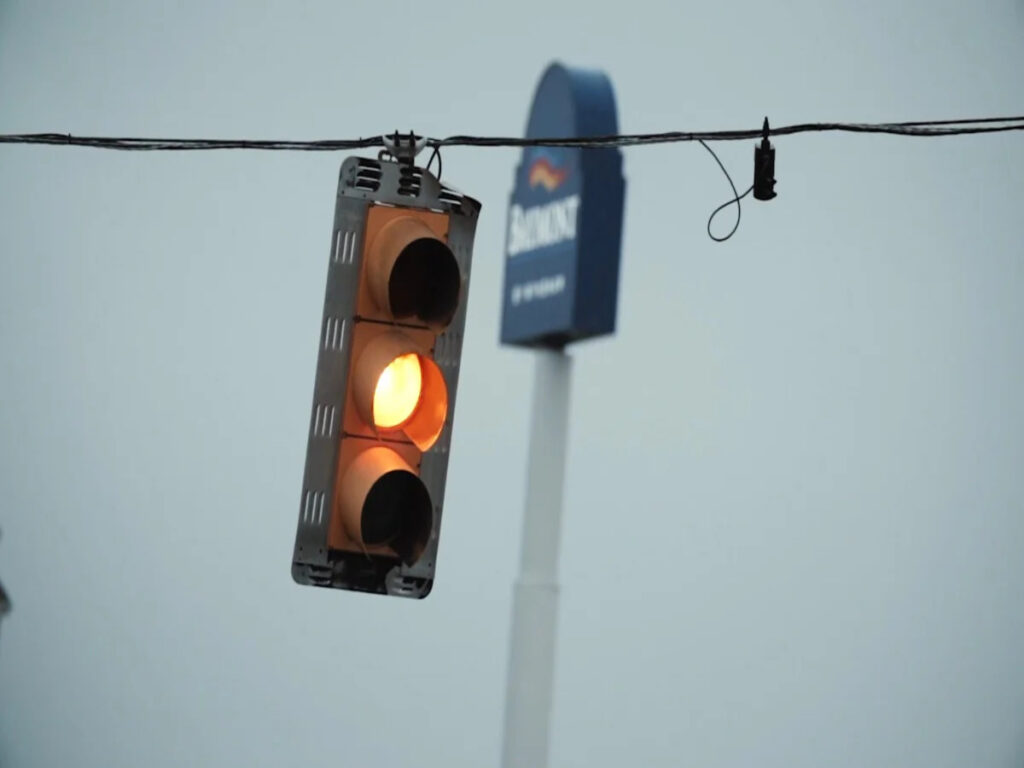
संभावित देरी की चेतावनी देने के लिए स्मार्ट कोन का उपयोग करना
स्मार्ट कोन आपको सड़क पर संभावित देरी के बारे में सूचित रखने में महत्वपूर्ण भूमिका निभाते हैं. ये शंकु यातायात स्थितियों में परिवर्तन का पता लगाने के लिए वास्तविक समय की निगरानी का उपयोग करते हैं, जैसे भीड़भाड़ या दुर्घटनाएँ. फिर वे इस जानकारी को ट्रैफ़िक प्रबंधन प्रणालियों को रिले करते हैं, जो कनेक्टेड डिवाइस या वेरिएबल संदेश संकेतों के माध्यम से ड्राइवरों को सचेत कर सकता है. उदाहरण के लिए, यदि किसी दुर्घटना के कारण अत्यधिक भीड़-भाड़ वाला क्षेत्र विकसित हो जाता है, स्मार्ट कोन आपको पहले से सूचित कर सकता है, आपको अपना मार्ग या समय समायोजित करने की अनुमति देता है.
उनकी उन्नत परावर्तक सामग्री और एलईडी लाइटें कम रोशनी की स्थिति में भी दृश्यता सुनिश्चित करती हैं, उन्हें यातायात नियंत्रण के लिए विश्वसनीय उपकरण बनाना. आपको देरी या आने वाले खतरों के बारे में चेतावनी देकर, स्मार्ट कोन आपको सुरक्षित और अधिक कुशल यात्रा निर्णय लेने में मदद करते हैं. यह सक्रिय दृष्टिकोण अप्रत्याशित व्यवधानों के तनाव को कम करता है और समग्र गतिशीलता में सुधार करता है.
उसी प्रकार, ओपीटी यातायात शंकु पर हस्ताक्षर करता है, अपने चमकीले रंगों और टिकाऊ डिज़ाइन के साथ, सड़क पर उत्कृष्ट दृश्यता और सुरक्षा प्रदान करें. चाहे आप किसी निर्माण स्थल का प्रबंधन कर रहे हों या व्यस्त क्षेत्रों में यातायात का मार्गदर्शन कर रहे हों, ओपीटीसंकेत ट्रैफ़िक शंकु व्यवस्था बनाए रखने में मदद करते हैं और श्रमिकों और ड्राइवरों दोनों की सुरक्षा सुनिश्चित करते हैं.
वास्तविक समय अलर्ट के साथ सड़क सुरक्षा में सुधार
स्मार्ट कोन से वास्तविक समय के अलर्ट सड़क सुरक्षा को महत्वपूर्ण रूप से बढ़ाते हैं. ये कोन लगातार यातायात प्रवाह की निगरानी करते हैं और दुर्घटनाओं जैसे खतरों का पता लगाते हैं, मार्ग, या प्रतिकूल मौसम की स्थिति. जब किसी जोखिम की पहचान हो जाती है, वे ड्राइवरों और यातायात प्रबंधन प्रणालियों को तत्काल अलर्ट भेजते हैं. यह आपको अपनी गति को समायोजित करके या लेन बदलकर तुरंत प्रतिक्रिया देने की अनुमति देता है, दुर्घटनाओं की संभावना को कम करना.
आपात स्थितियों के दौरान, स्मार्ट कोन दुर्घटना स्थलों के आसपास सुरक्षित परिधि स्थापित करते हैं. यह प्रथम प्रतिक्रियाकर्ताओं की सुरक्षा करता है और यातायात को खतरे वाले क्षेत्रों से दूर ले जाता है. उनकी एलईडी लाइटें और परावर्तक सामग्री दृश्यता को और बढ़ाती हैं, विशेषकर रात में या खराब मौसम में. आपको सूचित रखकर और यातायात प्रवाह का मार्गदर्शन करके, स्मार्ट कोन सभी के लिए सुरक्षित सड़कें बनाते हैं.
भीड़-भाड़ से संबंधित टकरावों को कम करना
भीड़-भाड़ से संबंधित टकराव अक्सर ऐसा तब होता है जब ड्राइवरों को अचानक रुकने या अप्रत्याशित ट्रैफ़िक पैटर्न का सामना करना पड़ता है. स्मार्ट कोन यातायात की भीड़ और सड़क की स्थिति पर वास्तविक समय पर अपडेट प्रदान करके इस समस्या का समाधान करते हैं. उनके अंतर्निर्मित सेंसर मंदी या बाधाओं का पता लगाते हैं और ट्रैफ़िक प्रबंधन प्रणालियों को सचेत करते हैं, जो फिर यातायात संकेतों को समायोजित कर सकता है या वैकल्पिक मार्ग सुझा सकता है. इससे अचानक रुकना कम हो जाता है और पीछे की ओर टकराव का जोखिम कम हो जाता है.
अत्यधिक भीड़-भाड़ वाले इलाकों में, स्मार्ट कोन दृश्यता में सुधार करते हैं और भीड़-भाड़ वाले क्षेत्रों में वाहनों का सुरक्षित मार्गदर्शन करते हैं. ट्रैफ़िक स्थितियों की निगरानी और संचार करने की उनकी क्षमता आपको सूचित निर्णय लेने में मदद करती है, दुर्घटनाओं की संभावना को कम करना. यातायात प्रवाह को अनुकूलित करके और सुरक्षा बढ़ाकर, स्मार्ट कोन अधिक कुशल और सुरक्षित परिवहन प्रणाली में योगदान करते हैं.
स्मार्ट ट्रैफिक कोन्स के उपयोग में चुनौतियाँ और समाधान
लागत चुनौतियाँ
स्मार्ट ट्रैफिक कोन को अपनाने में महत्वपूर्ण वित्तीय निवेश शामिल हो सकता है. इन प्रणालियों को खरीदने और स्थापित करने की प्रारंभिक लागत नगर निगम के बजट पर दबाव डाल सकती है. इसके अतिरिक्त, चल रही रखरखाव, जैसे सॉफ़्टवेयर अद्यतन और हार्डवेयर मरम्मत, खर्चों में इजाफा करता है. शहरों को अक्सर अन्य बुनियादी ढांचे की जरूरतों को संतुलित करते हुए इन उन्नत प्रौद्योगिकियों के लिए धन आवंटित करने में चुनौतियों का सामना करना पड़ता है.
डेटा सटीकता और विश्वसनीयता मुद्दे
स्मार्ट ट्रैफ़िक कोन की प्रभावशीलता उनके द्वारा एकत्र किए गए डेटा की सटीकता पर निर्भर करती है. गलत या अधूरा डेटा ट्रैफ़िक प्रबंधन को बाधित कर सकता है और खराब निर्णय लेने का कारण बन सकता है. उदाहरण के लिए, सॉफ़्टवेयर गड़बड़ियों के कारण वास्तविक समय की ट्रैफ़िक स्थितियों को प्रसारित करने में देरी हो सकती है, यातायात प्रवाह और सुरक्षा को प्रभावित करना.
सार्वजनिक स्वीकृति और अपनाना
स्मार्ट ट्रैफिक कोन की सफलता में सार्वजनिक स्वीकृति महत्वपूर्ण भूमिका निभाती है. कुछ व्यक्ति जागरूकता या विश्वास की कमी के कारण नई तकनीकों को अपनाने का विरोध कर सकते हैं. स्मार्ट कोन के लाभों के बारे में जनता को शिक्षित करना, जैसे बेहतर सड़क सुरक्षा और कम भीड़भाड़, इस प्रतिरोध पर काबू पाने में मदद मिल सकती है.
स्मार्ट कोन्स के साथ यातायात प्रबंधन का भविष्य
यात्रा समय की विश्वसनीयता में क्रांति लाने में स्मार्ट ट्रैफिक कोन की क्षमता
स्मार्ट ट्रैफिक कोन आपके यात्रा समय की विश्वसनीयता के अनुभव को बदलने के लिए तैयार हैं. ये शंकु IoT कनेक्टिविटी और सेंसर जैसी उन्नत प्रौद्योगिकियों को एकीकृत करते हैं, उन्हें सड़क की स्थिति पर वास्तविक समय डेटा एकत्र करने और प्रसारित करने में सक्षम बनाना. यह डेटा ट्रैफ़िक नियंत्रण केंद्रों को आपात स्थिति में तुरंत प्रतिक्रिया देने की अनुमति देता है, देरी को कम करना और सुचारू यातायात प्रवाह सुनिश्चित करना. स्वचालन सुविधाएँ उनकी कार्यक्षमता को और बढ़ाती हैं, सड़कों को सुरक्षित और अधिक कुशल बनाना.
स्मार्ट कोन के भविष्य के डिजाइनों में संभवतः हल्के और बंधने योग्य संरचनाएं शामिल होंगी, जिससे उन्हें विभिन्न स्थानों पर तैनात करना आसान हो जाता है. इन प्रगतियों से निर्माण क्षेत्रों में उनकी उपयोगिता में सुधार होगा, दुर्घटना स्थल, और उच्च-ट्रैफ़िक क्षेत्र. ट्रैफ़िक पैटर्न की लगातार निगरानी करके और कार्रवाई योग्य अंतर्दृष्टि प्रदान करके, स्मार्ट कोन आपको अधिक सटीकता के साथ अपनी यात्राओं की योजना बनाने में मदद करेंगे. यातायात प्रवाह को अनुकूलित करने की उनकी क्षमता से भीड़भाड़ भी कम होगी, ईंधन की खपत, और उत्सर्जन, अधिक टिकाऊ शहरी वातावरण में योगदान देना.
कैसे स्मार्ट ट्रैफिक कोन यात्रा और यातायात सुरक्षा के भविष्य को आकार दे सकते हैं
स्मार्ट ट्रैफिक शंकु ड्राइवरों और पैदल चलने वालों दोनों के लिए सुरक्षा को फिर से परिभाषित करेंगे. ये कोन वास्तविक समय में सड़क की स्थिति की निगरानी करते हैं, आपको दुर्घटनाओं जैसे खतरों के प्रति सचेत करता है, मार्ग, या प्रतिकूल मौसम. समय पर अपडेट प्रदान करके, वे आपको सुरक्षित निर्णय लेने में मदद करते हैं, जैसे कि अपनी गति समायोजित करना या वैकल्पिक मार्ग चुनना. आपात स्थितियों के दौरान, स्मार्ट कोन दुर्घटना स्थलों के आसपास सुरक्षित परिधि स्थापित करते हैं, यातायात को खतरे से दूर रखना और द्वितीयक टकरावों को रोकना.
निर्माण क्षेत्र में, स्मार्ट कोन ट्रैफ़िक पैटर्न की निगरानी करके और ड्राइवरों को अलर्ट भेजकर कर्मचारी सुरक्षा बढ़ाते हैं. स्वायत्त वाहनों के साथ बातचीत करने की उनकी क्षमता सुरक्षित नेविगेशन भी सुनिश्चित करती है, क्योंकि वे सड़क की स्थिति के बारे में महत्वपूर्ण डेटा सीधे वाहन प्रणालियों तक पहुंचाते हैं. यह एकीकरण स्मार्ट सिटी पहल के व्यापक लक्ष्यों का समर्थन करता है, सुरक्षित और अधिक कुशल परिवहन नेटवर्क को बढ़ावा देना.
स्मार्ट कोन के पर्यावरणीय लाभ उनके महत्व को और उजागर करते हैं. यातायात प्रवाह को अनुकूलित करके और भीड़भाड़ को कम करके, वे वाहन उत्सर्जन और ईंधन की खपत को कम करते हैं. अधिक समय तक, ये सुधार स्वच्छ हवा और पर्यावरणीय प्रभाव को कम करने में योगदान करते हैं. जैसे-जैसे शहर स्मार्ट परिवहन प्रौद्योगिकियों को अपनाते हैं, स्मार्ट कोन सुरक्षित बनाने के प्रयासों में सबसे आगे रहेंगे, ग्रीनर, और अधिक टिकाऊ शहरी स्थान.
स्मार्ट ट्रैफ़िक कोन ने आपके ट्रैफ़िक प्रवाह और सड़क सुरक्षा का अनुभव करने के तरीके में क्रांति ला दी है. उनकी उन्नत सुविधाएँ, जैसे एलईडी लाइट्स और IoT कनेक्टिविटी, दृश्यता बढ़ाएं और यात्रा समय की स्थिरता को अनुकूलित करने के लिए वास्तविक समय डेटा प्रदान करें. सिंगापुर जैसी जगहों पर, इन शंकुओं ने दुर्घटनाओं और भीड़भाड़ को काफी हद तक कम कर दिया है, प्रभावी स्मार्ट सिटी समाधान के रूप में अपनी क्षमता का प्रदर्शन. कनेक्टेड ट्रैफिक लाइट सिस्टम के साथ एकीकरण करके, वे गतिशील यातायात प्रबंधन सक्षम करते हैं, सुरक्षित और अधिक कुशल सड़कें सुनिश्चित करना.
इस तकनीक को अपनाने से अत्यधिक लाभ मिलता है. आपको सुरक्षित यात्रा अनुभव प्राप्त होता है, देरी कम हुई, और एक अधिक टिकाऊ शहरी वातावरण. हितधारकों को स्मार्ट बनाने के लिए स्मार्ट कोन को लागू करने को प्राथमिकता देनी चाहिए, सभी के लिए सुरक्षित सड़कें.
